Section Exercises
1. Explain the advantage of writing a quadratic function in standard form. 2. How can the vertex of a parabola be used in solving real world problems? 3. Explain why the condition of [latex]a\ne 0\\[/latex] is imposed in the definition of the quadratic function. 4. What is another name for the standard form of a quadratic function? 5. What two algebraic methods can be used to find the horizontal intercepts of a quadratic function? For the following exercises, rewrite the quadratic functions in standard form and give the vertex. 6. [latex]f\left(x\right)={x}^{2}-12x+32\\[/latex] 7. [latex]g\left(x\right)={x}^{2}+2x - 3\\[/latex] 8. [latex]f\left(x\right)={x}^{2}-x\\[/latex] 9. [latex]f\left(x\right)={x}^{2}+5x - 2\\[/latex] 10. [latex]h\left(x\right)=2{x}^{2}+8x - 10\\[/latex] 11. [latex]k\left(x\right)=3{x}^{2}-6x - 9\\[/latex] 12. [latex]f\left(x\right)=2{x}^{2}-6x\\[/latex] 13. [latex]f\left(x\right)=3{x}^{2}-5x - 1\\[/latex] For the following exercises, determine whether there is a minimum or maximum value to each quadratic function. Find the value and the axis of symmetry. 14. [latex]y\left(x\right)=2{x}^{2}+10x+12\\[/latex] 15. [latex]f\left(x\right)=2{x}^{2}-10x+4\\[/latex] 16. [latex]f\left(x\right)=-{x}^{2}+4x+3\\[/latex] 17. [latex]f\left(x\right)=4{x}^{2}+x - 1\\[/latex] 18. [latex]h\left(t\right)=-4{t}^{2}+6t - 1\\[/latex] 19. [latex]f\left(x\right)=\frac{1}{2}{x}^{2}+3x+1\\[/latex] 20. [latex]f\left(x\right)=-\frac{1}{3}{x}^{2}-2x+3\\[/latex] For the following exercises, determine the domain and range of the quadratic function. 21. [latex]f\left(x\right)={\left(x - 3\right)}^{2}+2\\[/latex] 22. [latex]f\left(x\right)=-2{\left(x+3\right)}^{2}-6\\[/latex] 23. [latex]f\left(x\right)={x}^{2}+6x+4\\[/latex] 24. [latex]f\left(x\right)=2{x}^{2}-4x+2\\[/latex] 25. [latex]k\left(x\right)=3{x}^{2}-6x - 9\\[/latex] For the following exercises, solve the equations over the complex numbers. 26. [latex]{x}^{2}=-25\\[/latex] 27. [latex]{x}^{2}=-8\\[/latex] 28. [latex]{x}^{2}+36=0\\[/latex] 29. [latex]{x}^{2}+27=0\\[/latex] 30. [latex]{x}^{2}+2x+5=0\\[/latex] 31. [latex]{x}^{2}-4x+5=0\\[/latex] 32. [latex]{x}^{2}+8x+25=0\\[/latex] 33. [latex]{x}^{2}-4x+13=0\\[/latex] 34. [latex]{x}^{2}+6x+25=0\\[/latex] 35. [latex]{x}^{2}-10x+26=0\\[/latex] 36. [latex]{x}^{2}-6x+10=0\\[/latex] 37. [latex]x\left(x - 4\right)=20\\[/latex] 38. [latex]x\left(x - 2\right)=10\\[/latex] 39. [latex]2{x}^{2}+2x+5=0\\[/latex] 40. [latex]5{x}^{2}-8x+5=0\\[/latex] 41. [latex]5{x}^{2}+6x+2=0\\[/latex] 42. [latex]2{x}^{2}-6x+5=0\\[/latex] 43. [latex]{x}^{2}+x+2=0\\[/latex] 44. [latex]{x}^{2}-2x+4=0\\[/latex] For the following exercises, use the vertex (h, k) and a point on the graph (x, y) to find the general form of the equation of the quadratic function. 45. [latex]\left(h,k\right)=\left(2,0\right),\left(x,y\right)=\left(4,4\right)\\[/latex] 46. [latex]\left(h,k\right)=\left(-2,-1\right),\left(x,y\right)=\left(-4,3\right)\\[/latex] 47. [latex]\left(h,k\right)=\left(0,1\right),\left(x,y\right)=\left(2,5\right)\\[/latex] 48. [latex]\left(h,k\right)=\left(2,3\right),\left(x,y\right)=\left(5,12\right)\\[/latex] 49. [latex]\left(h,k\right)=\left(-5,3\right),\left(x,y\right)=\left(2,9\right)\\[/latex] 50. [latex]\left(h,k\right)=\left(3,2\right),\left(x,y\right)=\left(10,1\right)\\[/latex] 51. [latex]\left(h,k\right)=\left(0,1\right),\left(x,y\right)=\left(1,0\right)\\[/latex] 52. [latex]\left(h,k\right)=\left(1,0\right),\left(x,y\right)=\left(0,1\right)\\[/latex] For the following exercises, sketch a graph of the quadratic function and give the vertex, axis of symmetry, and intercepts. 53. [latex]f\left(x\right)={x}^{2}-2x\\[/latex] 54. [latex]f\left(x\right)={x}^{2}-6x - 1\\[/latex] 55. [latex]f\left(x\right)={x}^{2}-5x - 6\\[/latex] 56. [latex]f\left(x\right)={x}^{2}-7x+3\\[/latex] 57. [latex]f\left(x\right)=-2{x}^{2}+5x - 8\\[/latex] 58. [latex]f\left(x\right)=4{x}^{2}-12x - 3\\[/latex] For the following exercises, write the equation for the graphed function. 59.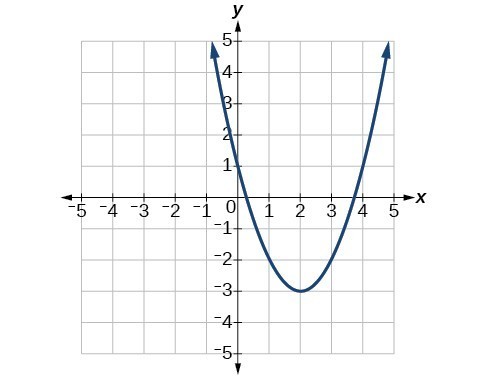 60.
60.
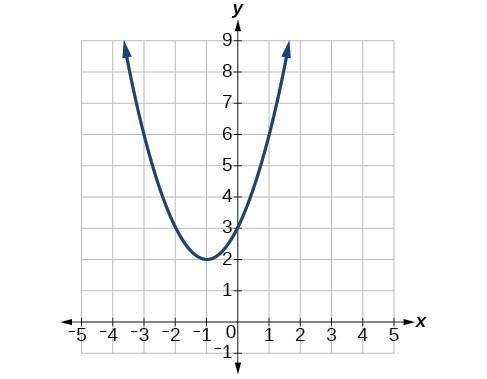 61.
61.
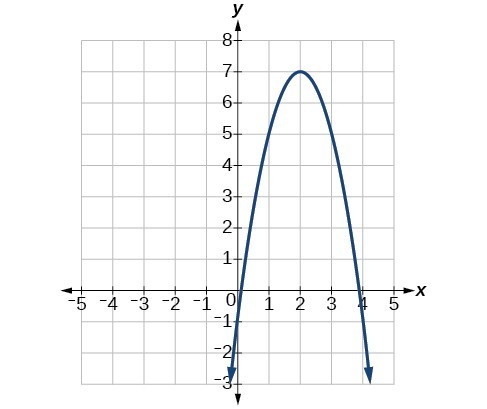 62.
62.
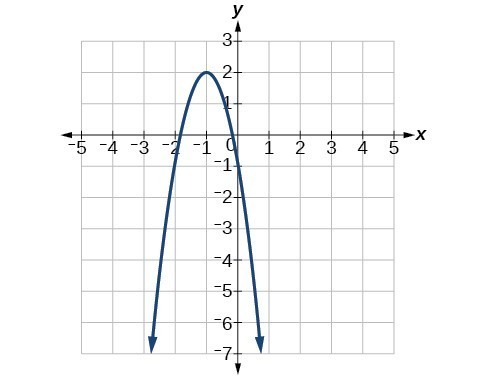 63.
63.
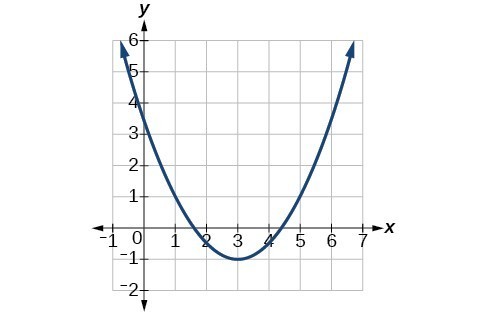 64.
64.
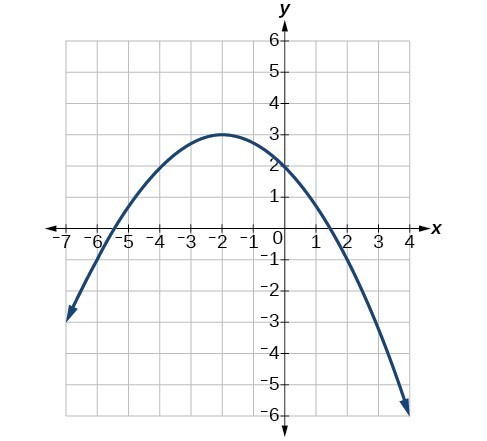 For the following exercises, use the table of values that represent points on the graph of a quadratic function. By determining the vertex and axis of symmetry, find the general form of the equation of the quadratic function.
65.
For the following exercises, use the table of values that represent points on the graph of a quadratic function. By determining the vertex and axis of symmetry, find the general form of the equation of the quadratic function.
65.
| x | –2 | –1 | 0 | 1 | 2 |
| y | 5 | 2 | 1 | 2 | 5 |
| x | –2 | –1 | 0 | 1 | 2 |
| y | 1 | 0 | 1 | 4 | 9 |
| x | –2 | –1 | 0 | 1 | 2 |
| y | –2 | 1 | 2 | 1 | –2 |
| x | –2 | –1 | 0 | 1 | 2 |
| y | –8 | –3 | 0 | 1 | 0 |
| x | –2 | –1 | 0 | 1 | 2 |
| y | 8 | 2 | 0 | 2 | 8 |
Licenses & Attributions
CC licensed content, Shared previously
- Precalculus. Provided by: OpenStax Authored by: Jay Abramson, et al.. Located at: https://openstax.org/books/precalculus/pages/1-introduction-to-functions. License: CC BY: Attribution. License terms: Download For Free at : http://cnx.org/contents/[email protected]..
